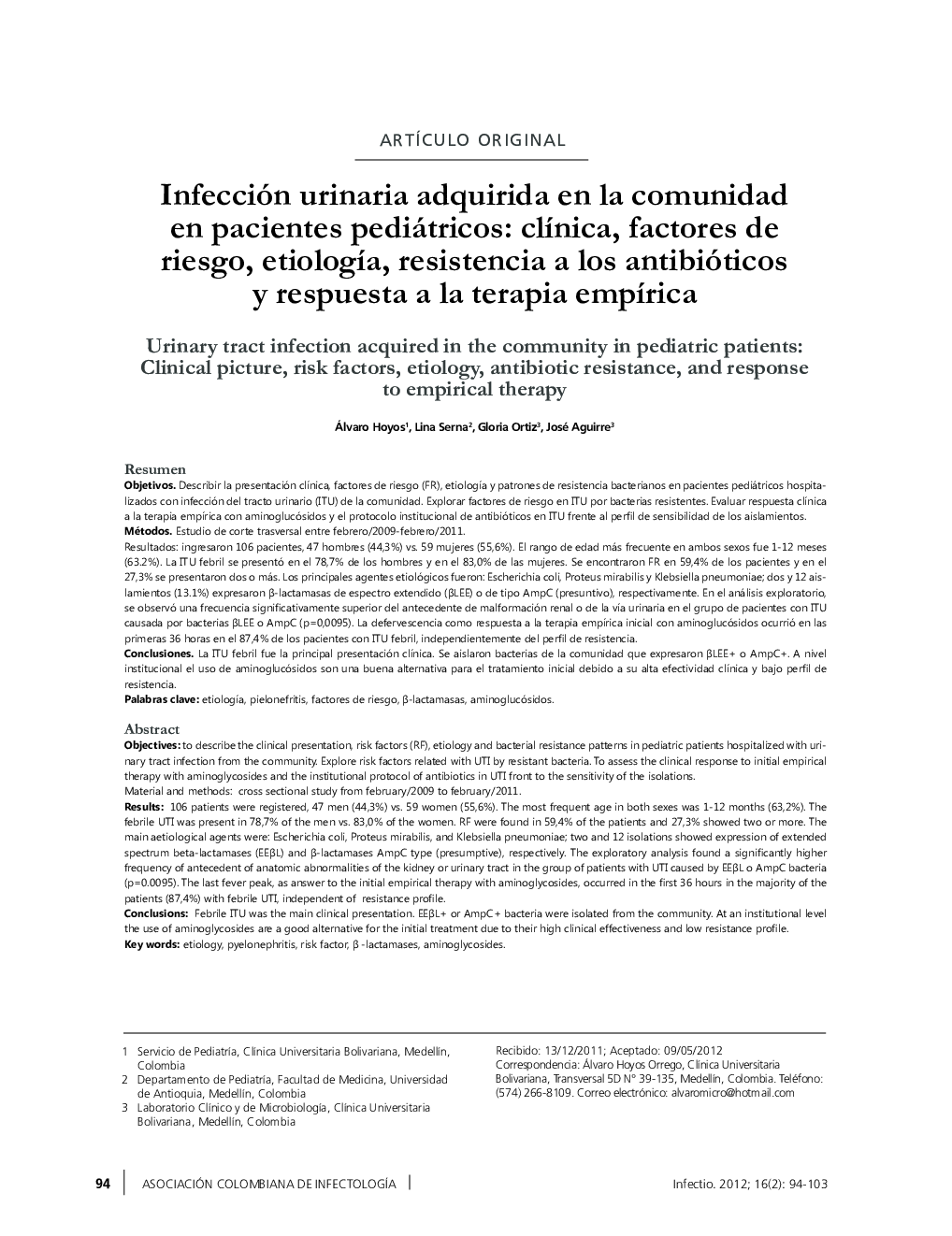| Article ID | Journal | Published Year | Pages | File Type |
|---|---|---|---|---|
| 3403690 | Infectio | 2012 | 10 Pages |
ResumenObjetivosDescribir la presentación clínica, factores de riesgo (FR), etiología y patrones de resistencia bacterianos en pacientes pediátricos hospitalizados con infección del tracto urinario (ITU) de la comunidad. Explorar factores de riesgo en ITU por bacterias resistentes. Evaluar respuesta clínica a la terapia empírica con aminoglucósidos y el protocolo institucional de antibióticos en ITU frente al perfil de sensibilidad de los aislamientos.MétodosEstudio de corte trasversal entre febrero/2009-febrero/2011.Resultadosingresaron 106 pacientes, 47 hombres (44,3%) vs. 59 mujeres (55,6%). El rango de edad más frecuente en ambos sexos fue 1-12 meses (63.2%). La ITU febril se presentó en el 78,7% de los hombres y en el 83,0% de las mujeres. Se encontraron FR en 59,4% de los pacientes y en el 27,3% se presentaron dos o más. Los principales agentes etiológicos fueron: Escherichia coli, Proteus mirabilis y Klebsiella pneumoniae; dos y 12 aislamientos (13.1%) expresaron β-lactamasas de espectro extendido (βLEE) o de tipo AmpC (presuntivo), respectivamente. En el análisis exploratorio, se observó una frecuencia significativamente superior del antecedente de malformación renal o de la vía urinaria en el grupo de pacientes con ITU causada por bacterias βLEE o AmpC (p = 0,0095). La defervescencia como respuesta a la terapia empírica inicial con aminoglucósidos ocurrió en las primeras 36 horas en el 87,4% de los pacientes con ITU febril, independientemente del perfil de resistencia.ConclusionesLa ITU febril fue la principal presentación clínica. Se aislaron bacterias de la comunidad que expresaron βLEE+ o AmpC+. A nivel institucional el uso de aminoglucósidos son una buena alternativa para el tratamiento inicial debido a su alta efectividad clínica y bajo perfil de resistencia.
Objectivesto describe the clinical presentation, risk factors (RF), etiology and bacterial resistance patterns in pediatric patients hospitalized with urinary tract infection from the community. Explore risk factors related with UTI by resistant bacteria. To assess the clinical response to initial empirical therapy with aminoglycosides and the institutional protocol of antibiotics in UTI front to the sensitivity of the isolations.Material and methodscross sectional study from february/2009 to february/2011.Results106 patients were registered, 47 men (44,3%) vs. 59 women (55,6%). The most frequent age in both sexes was 1-12 months (63,2%). The febrile UTI was present in 78,7% of the men vs. 83,0% of the women. RF were found in 59,4% of the patients and 27,3% showed two or more. The main aetiological agents were: Escherichia coli, Proteus mirabilis, and Klebsiella pneumoniae; two and 12 isolations showed expression of extended spectrum beta-lactamases (EEβL) and β-lactamases AmpC type (presumptive), respectively. The exploratory analysis found a significantly higher frequency of antecedent of anatomic abnormalities of the kidney or urinary tract in the group of patients with UTI caused by EEβL o AmpC bacteria (p = 0.0095). The last fever peak, as answer to the initial empirical therapy with aminoglycosides, occurred in the first 36 hours in the majority of the patients (87,4%) with febrile UTI, independent of resistance profile.ConclusionsFebrile ITU was the main clinical presentation. EEβL+ or AmpC+ bacteria were isolated from the community. At an institutional level the use of aminoglycosides are a good alternative for the initial treatment due to their high clinical effectiveness and low resistance profile.
